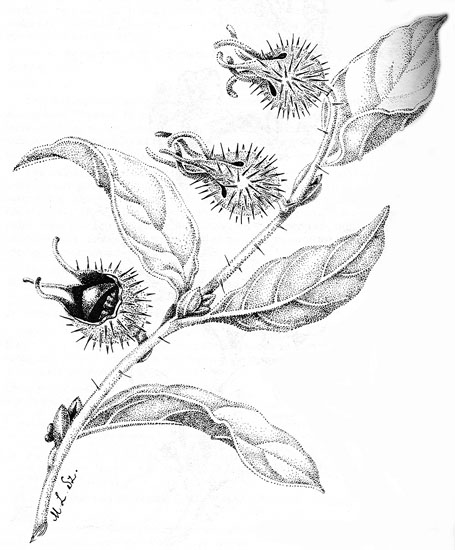
Synonymy
Solanum vansittartense C. Gardner, W. Austral. Forest. Dept. Bull. 32: 89 (1923); sometimes also as 'vansittartensis'.
T: 4 to 8 miles (6-12 km) S of Vansittart Bay, W.A., 7 Aug. 1921, C.A. Gardner 1516; holo: PERTH.
Description
Erect shrub to 3 m, green, male or bisexual, densely pubescent with stellate hairs; prickles to 10 mm long, abundant on calyx of bisexual flower, scattered to absent elsewhere.
Leaves ovate, the upper ones narrowly lanceolate; lamina 5-10 cm long, 2.5-6 cm wide, concolorous or slightly discolorous, entire; petiole 5-20 mm long.
Male plant: inflorescence condensed, at least 12-flowered; peduncle c. 10 mm long; pedicels c. 5 mm long; calyx 7-10 mm long, the lobes lanceolate, 5-7 mm long; corolla broadly stellate to pentagonal, c. 25 mm diam., purple; anthers c. 7 mm long. Bisexual plant: flowers not known; fruiting pedicel absent or up to c. 5 mm long; fruiting calyx c. 25 mm diam., covering fruit; lobes triangular with linear apices, 20 mm long.
Berry drying within calyx, the upper portion splitting around circumference in upper portion to form a loose cap. Seeds 2.5 mm long, black.
Distribution and ecology
A poorly known species from the North Kimberley, W.A.; occurs on sandy patches over sandstone.
Relationships
Martine et al. (2006) have shown that S. vansittartense belongs with the other functionally dioecious species within the Dioicum complex. All of the dioecious members of the Dioicum group of subgen. Leptostemonum exhibit functional dioecy i.e. male flowers are borne on separate plants from what appear to be plants with bisexual or hermaphrodite flowers; while these bisexual flowers do produce pollen, it is inaperturate and does not germinate, making the flowers effectively female (Knapp et al.,1998).
Initial molecular studies by Martine et al. (2006) suggested that the two functionally dioecious species from Kakadu, S. asymmetriphyllum and the newly described S. sejunctum, formed a separate clade and had arisen separately from the other dioecious members of the Dioicum group, S. cunninghamii, S. cataphractum , S. dioicum, S. petraeum, S. carduiforme, S. tudununggae, S. vansittartense and S. leopoldense. This initial DNA analysis involved sequencing of the ITS region of nuclear rDNA.
However further molecular analysis involving the trnK-matK gene region indicated that all of the functionally dioecious species form a single clade arising from the andromononoecious species of the group (Martine et al., 2009).
Many of these dioecious species remain undercollected and poorly understood and it is likely that some of these names will be changed with further work.
A single collection of S. vansittartense was included in the initial ITS DNA analysis and this indicated a close relationship with an unidentified taxon and S. dioicum . This species was not represented in the second analysis.
References: S.Knapp, V.Persson & S.Blackmore (1998). Pollen morphology and functional dioecy in Solanum (Solanaceae). Pl. Syst. Evol. 210:113-139.; Martine, C.T., D. Vanderpool, G.J. Anderson, and D.H. Les (2006). Phylogenetic relationships of andromonoecious and dioecious Australian species of Solanum subgenus Leptostemonum section Melongena: Inferences from ITS sequence data. Systematic Botany 31: 410-420; Martine, C.T., G.J. Anderson & D.H. Les (2006). Gender-bending aubergines; molecular phylogenetics of cryptically dioecious Solanum in Australia. Australian Systematic Botany 22: 107-120.
Derivation of epithet
Named for the locality of the type collection, Vansittart Bay in the Kimberley region of WA.
Selected specimens
W.A.: Mitchell Plateau, K.F. Kenneally 4793 (AD, CANB, PERTH).
Plant status, if any
Previously classified as Risk Code 2K (Briggs & Leigh, Rare or Threatened Australian Plants, 1995), but no longer considered to be threatened - see FloraBase site.
From the web
There is presently limited information for this species on either the FloraBase site or the Solanaceae Source site.


